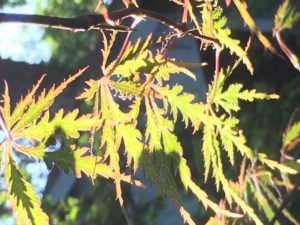 Finally, like getting bubble gum off the bottom of my shoe, summer is letting go. There are still strings and strands of heat and humidity lingering on but for the most part, the long, hot days of Summer 2017 are over. It might be a while before we pull out the winter coats but for now, I’m thrilled to be wearing a sweatshirt.
Finally, like getting bubble gum off the bottom of my shoe, summer is letting go. There are still strings and strands of heat and humidity lingering on but for the most part, the long, hot days of Summer 2017 are over. It might be a while before we pull out the winter coats but for now, I’m thrilled to be wearing a sweatshirt.
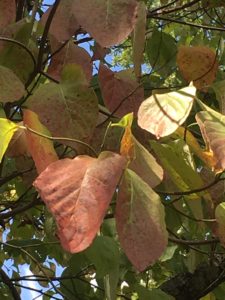 My garden is definitely glad to shake off the end-of-the season blahs and look toward something new and fresh. Pulling out old, scraggly way-past-prime annuals feels like brushing tangles out of my hair. It is lovely to have everything neat and orderly again.
My garden is definitely glad to shake off the end-of-the season blahs and look toward something new and fresh. Pulling out old, scraggly way-past-prime annuals feels like brushing tangles out of my hair. It is lovely to have everything neat and orderly again.
But in the midst of yellowing oaks, orang-ing dogwoods and scarlet-ing maples,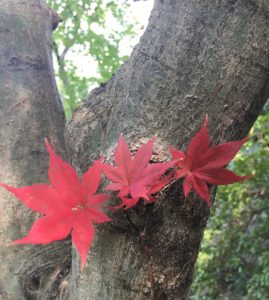 there are definite signs of spring-like growth. I’m not talking about plants confused by lingering warm temperatures paired with shorter sunlight hours making them think it’s spring, like daffodils that might be putting up leaves. Instead, I’m talking about those plants whose natural growth cycle causes them to put out fresh, green growth right now at the beginning of fall.
there are definite signs of spring-like growth. I’m not talking about plants confused by lingering warm temperatures paired with shorter sunlight hours making them think it’s spring, like daffodils that might be putting up leaves. Instead, I’m talking about those plants whose natural growth cycle causes them to put out fresh, green growth right now at the beginning of fall.
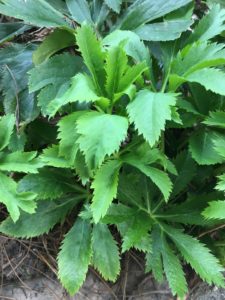 Probably the most conspicuous of these is Helleborus, Lenten rose, whose peak blooming season is mid-winter. Beginning in January, these plants brave the cold (and sometimes ice and snow) to bring us an abundance of lovely white or dusky rose colored blossoms.
Probably the most conspicuous of these is Helleborus, Lenten rose, whose peak blooming season is mid-winter. Beginning in January, these plants brave the cold (and sometimes ice and snow) to bring us an abundance of lovely white or dusky rose colored blossoms. 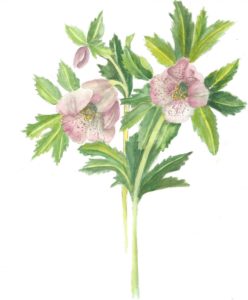
But their growth cycle begins now, when they are putting out new, bright green leaves, at the same time that most other perennials are shutting down for the season. Lenten rose is a great, easy to grow perennial. This is a good time to plant them. If you have friends who grow this plant, they are sure to have extras to share as lenten rose multiplies quickly.
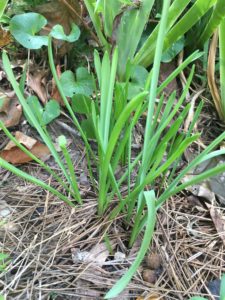
Another example is grape hyacinth, a small but beautiful plant that grows from a bulb. Although it doesn’t bloom until spring, the grass like leaves are coming up now. The blossom of this is made up of a stalk of bluish purple buds that never fully open and remain looking like small balls or grapes (thus the common name). It is a great plant for mid spring and looks good with yellow daffodils and European primrose.
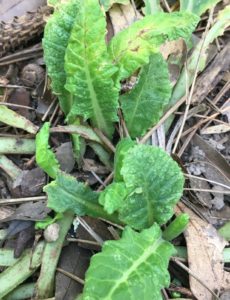
Speaking of which, the small English primrose (Primula veris), related to but (in my opinion superior to) the garishly colored hot house primrose (Primula vulgaris), is another great perennial that is putting out new growth right now. This plant is traditionally called “cowslip” in its native England. Cowslip puts out beautiful pale yellow flowers in mid spring. The flowering stalk is about 10 inches tall and grows from a basal rosette of crinkly leaves. 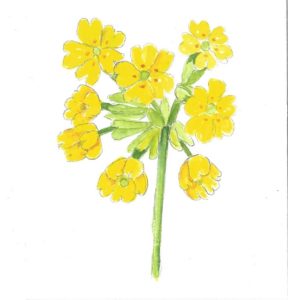 By fall these leaves are looking pretty tired and ragged but if you look closely, you’ll see the bright yellow green growth of new leaves, promising lovely spring flowers – as soon as winter is over!
By fall these leaves are looking pretty tired and ragged but if you look closely, you’ll see the bright yellow green growth of new leaves, promising lovely spring flowers – as soon as winter is over!
I love these alternate-season plants because they are living proof that “to everything there is a season.”

Thanks, Laura. I love the idea of fresh growth in Autumn. I find myself busy with new growth in this season, too.
I always learn so much from your blog. Your post reminded me that I pulled up our previous homeowner’s Helleborus when we moved in. Oddly, I knew the Latin name, but if I had known it was a “Lenten Rose” I might have kept it. I’m re-inspired to re-plant some.